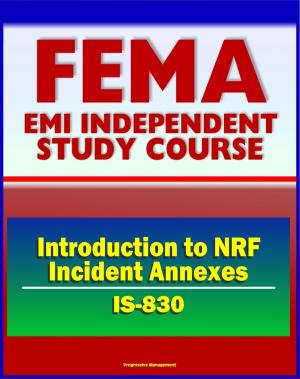U.S. Army Medical Correspondence Course: Fresh Fruits and Vegetables, Nuts and Herbs, Identification, Inspection, Grades, Storage, Types of Fruit, Terminology
Nonfiction, Food & Drink, Baking & Desserts, Fruit| Author: | Progressive Management | ISBN: | 9781310348600 |
| Publisher: | Progressive Management | Publication: | October 17, 2014 |
| Imprint: | Smashwords Edition | Language: | English |
| Author: | Progressive Management |
| ISBN: | 9781310348600 |
| Publisher: | Progressive Management |
| Publication: | October 17, 2014 |
| Imprint: | Smashwords Edition |
| Language: | English |
A substantial amount of the millions of dollars the military services spend each year on subsistence items is spent on fresh fruits and vegetables. More dollars are spent on meat and dairy products, yet the investment in fresh fruits and vegetables is fully as important in providing the soldier with a balanced diet. This subcourse provides an introduction to plant physiology and the military acquisition process. With the use of the Produce Identification Guide, it facilitates familiarization with the characteristics of a wide range of fresh fruit and vegetables. In addition, it shows common factors related to identity, condition, and quantity, while performing destination or surveillance inspections. It is essential for the veterinary food inspection specialist to be knowledgeable in these areas in order to ensure a fresh supply of fresh fruits and vegetables for the military services.
CHAPTER 1 - INTRODUCTION TO FRESH FRUITS AND VEGETABLES * Section I. Plant Characteristics * Section II. Acquisition of Fresh Fruits and Vegetables * Section III. Produce Identification * Exercises * CHAPTER 2 - IDENTIFICATION OF FRESH FRUITS * Exercises * CHAPTER 3 - IDENTIFICATION OF FRESH VEGETABLES * Exercises * CHAPTER 4 - IDENTIFICATION OF NUTS AND HERBS * Section I. Nuts * Section II. Herbs * Exercises * CHAPTER 5 - DESTINATION INSPECTION OF FRESH FRUITS AND VEGETABLES * Section I. Grades and Inspection Factors of Fresh Fruits and Vegetables * Section II. Destination Inspection Procedures of Fresh Fruits and Vegetables * Exercises * CHAPTER 6 - SURVEILLANCE INSPECTION OF FRESH FRUITS AND VEGETABLES * Section I. Storage of Fresh Fruits and Vegetables * Section II. Surveillance Inspection Procedures for Fresh Fruits and Vegetables * Exercises * Appendix A. Types of Fruits -- Botanical Classification * Appendix B. Terminology Used in the Standards * Appendix C. General Botanical Terminology--Vegetables and Herbs
Because of the development of new varieties of fruits and vegetables and improvements in equipment, fresh fruits and vegetables (FF&V) are available in substantial supply at all times of the year. More than 100 species of fresh fruits and vegetables can be found during the year at the large terminal markets. However, even with this large number of fruits and vegetables from which to choose, there are problems in supplying the military services with fruits and vegetables at the peak of their harvest quality. Fresh fruits and vegetables are highly perishable. All food inspection personnel have a most important role in getting the best quality product possible to the consumer.
Living Organisms. At the time of harvest, FF&V are living organisms that are still carrying on life processes. They are respiring, transpiring, producing food, maturing, and ripening. Because celery grows and potatoes and onions sprout during storage is physical evidence that fresh fruits and vegetables are living organisms.
Cells. Fresh fruits and vegetables are living organisms composed of cells. Cells are the basic structural units of plants and are composed mainly of cellulose. Plant cells have a cell wall. The cell wall encloses the protoplasm, which is the living part of the cell. The ability of plants to convert nonliving materials into living substance (protoplasm) distinguishes plants from nonliving entities.
A substantial amount of the millions of dollars the military services spend each year on subsistence items is spent on fresh fruits and vegetables. More dollars are spent on meat and dairy products, yet the investment in fresh fruits and vegetables is fully as important in providing the soldier with a balanced diet. This subcourse provides an introduction to plant physiology and the military acquisition process. With the use of the Produce Identification Guide, it facilitates familiarization with the characteristics of a wide range of fresh fruit and vegetables. In addition, it shows common factors related to identity, condition, and quantity, while performing destination or surveillance inspections. It is essential for the veterinary food inspection specialist to be knowledgeable in these areas in order to ensure a fresh supply of fresh fruits and vegetables for the military services.
CHAPTER 1 - INTRODUCTION TO FRESH FRUITS AND VEGETABLES * Section I. Plant Characteristics * Section II. Acquisition of Fresh Fruits and Vegetables * Section III. Produce Identification * Exercises * CHAPTER 2 - IDENTIFICATION OF FRESH FRUITS * Exercises * CHAPTER 3 - IDENTIFICATION OF FRESH VEGETABLES * Exercises * CHAPTER 4 - IDENTIFICATION OF NUTS AND HERBS * Section I. Nuts * Section II. Herbs * Exercises * CHAPTER 5 - DESTINATION INSPECTION OF FRESH FRUITS AND VEGETABLES * Section I. Grades and Inspection Factors of Fresh Fruits and Vegetables * Section II. Destination Inspection Procedures of Fresh Fruits and Vegetables * Exercises * CHAPTER 6 - SURVEILLANCE INSPECTION OF FRESH FRUITS AND VEGETABLES * Section I. Storage of Fresh Fruits and Vegetables * Section II. Surveillance Inspection Procedures for Fresh Fruits and Vegetables * Exercises * Appendix A. Types of Fruits -- Botanical Classification * Appendix B. Terminology Used in the Standards * Appendix C. General Botanical Terminology--Vegetables and Herbs
Because of the development of new varieties of fruits and vegetables and improvements in equipment, fresh fruits and vegetables (FF&V) are available in substantial supply at all times of the year. More than 100 species of fresh fruits and vegetables can be found during the year at the large terminal markets. However, even with this large number of fruits and vegetables from which to choose, there are problems in supplying the military services with fruits and vegetables at the peak of their harvest quality. Fresh fruits and vegetables are highly perishable. All food inspection personnel have a most important role in getting the best quality product possible to the consumer.
Living Organisms. At the time of harvest, FF&V are living organisms that are still carrying on life processes. They are respiring, transpiring, producing food, maturing, and ripening. Because celery grows and potatoes and onions sprout during storage is physical evidence that fresh fruits and vegetables are living organisms.
Cells. Fresh fruits and vegetables are living organisms composed of cells. Cells are the basic structural units of plants and are composed mainly of cellulose. Plant cells have a cell wall. The cell wall encloses the protoplasm, which is the living part of the cell. The ability of plants to convert nonliving materials into living substance (protoplasm) distinguishes plants from nonliving entities.















